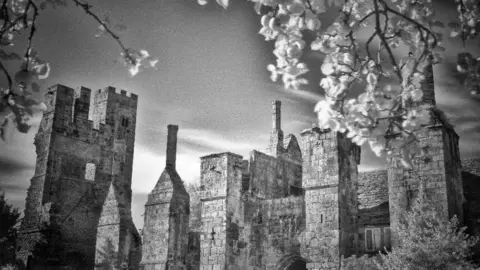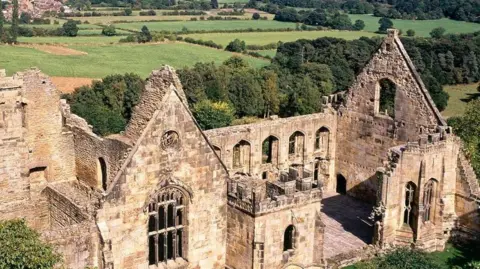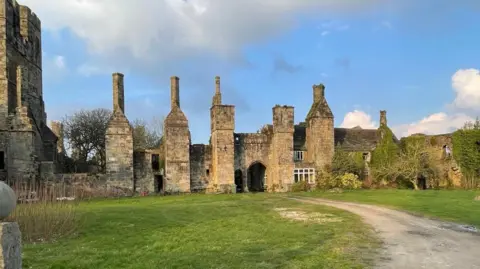The manor that 'helped shape modern England'
 John Parker
John ParkerA manor that imprisoned Mary, Queen of Scots was also home to an advisor to Henry VI and a scientist who had a major influence on modern astronomy during its near 600 years of existence.
Campaigners are calling for English Heritage to carry out urgent repairs to the palatial ruins of Derbyshire's Wingfield Manor so people can visit the home once again and learn about its "fascinating history".
Dr Nigel Hunt, who is writing a book about the manor, said its inhabitants included nationally important figures.
Arguably one of the home's most interesting tales involves owner George, 6th Earl of Shrewsbury, who found himself as the reluctant jailer of Mary, Queen of Scots.
 PA Media
PA Media"He had a really rotten time," said Dr Hunt.
"George was torn between three powerful women. He had a lot of hassle from Queen Elizabeth I, who was worried about his loyalty to her over Mary, Queen of Scots.
"Mary also constantly complained about her treatment at Wingfield Manor and said it was dirty.
"Then his wife, Bess of Hardwick, was jealous of Mary as she thought he was having an affair with her, which I don't think was true."
Knights of the Garter
However, Dr Hunt believes the Mary, Queen of Scots era was not the most important time in the manor's history.
It is estimated the grand house was built during the 1440s for Ralph, Lord Cromwell, Treasurer of England, although the site is thought to have been occupied from the 12th Century.
Lord Cromwell, from Lambley in Nottinghamshire, fought at Agincourt - a significant battle in the Hundred Years' War - and held a number of government roles, which included being a member of the council that advised Henry VI before he came of age.
On his death the manor passed to the 2nd Earl of Shrewsbury, who fought in the bloody War of the Roses, where he eventually died during the Battle of Northampton in 1460.
 English Heritage
English Heritage"Some of the manor's inhabitants were nationally important figures... they helped shape modern England," Dr Hunt said.
"The earls of Shrewsbury were Knights of the Garter, they fought in France and Scotland and demonstrate the importance of the manor."
He said the manor also played an important part in the English Civil War.
"It was besieged by Royalists in 1642 and then Parliamentarians in 1644 and you can still see damage caused by cannonballs on the manor today," he said.
"Some of the trenches have never been dug out, so there's still potentially a lot to discover there."
Dr Hunt said another of the manor's inhabitants, Immanuel Halton, had a major influence on modern astronomy and mathematics.
"He discovered John Flamsteed, who became Astronomer Royal and wrote a scientific paper on a partial solar eclipse he witnessed from the manor in the 1670s," he said.
"Then two of the daughters who inherited the manor from their father Gilbert, 7th Earl of Shrewsbury, both wrote books on how food could be used to cure diseases and were scientists in their own right."
Barry Joyce, vice-chair of the Derbyshire Historic Buildings Trust, said the manor needed to be open to the public once more.
 Barry Joyce
Barry Joyce"My concern now is to try to encourage English Heritage... to put it back into a decent state, so that the public can enjoy it again and learn about its fascinating history," he said.
Mr Joyce said the manor had even been mentioned in books including D. H. Lawrence's Sons and Lovers and Alison Utley's A Traveller in Time.
"It really is a magnificent building and was up there with Haddon Hall, Chatsworth and Hardwick Hall," he said.
"People could visit it easily because of the nearby railway."
Full conservation project
In a statement, English Heritage said Wingfield Manor had "long been largely ruined and roofless and modern agricultural use has concealed parts of the historic complex".
It added: "The two edges of the site are in the guardianship of the state and managed by English Heritage while the central section remains in private ownership.
"With it being originally conceived and built as a whole, this makes it a relatively complicated site on a number of levels, not least in terms of maintenance and conservation.
"We have previously discussed options for reuniting the site as a whole with the owner, but unfortunately we were not able to arrive at a consensus.
"Since English Heritage became a charity, we have spent more than £100,000 on repairs and maintenance work and we are developing a full conservation project for those elements of the site in our care.
"However, there are major challenges and costs involved with securing its future."
Follow BBC Derby on Facebook, on X, or on Instagram. Send your story ideas to [email protected] or via WhatsApp on 0808 100 2210.
